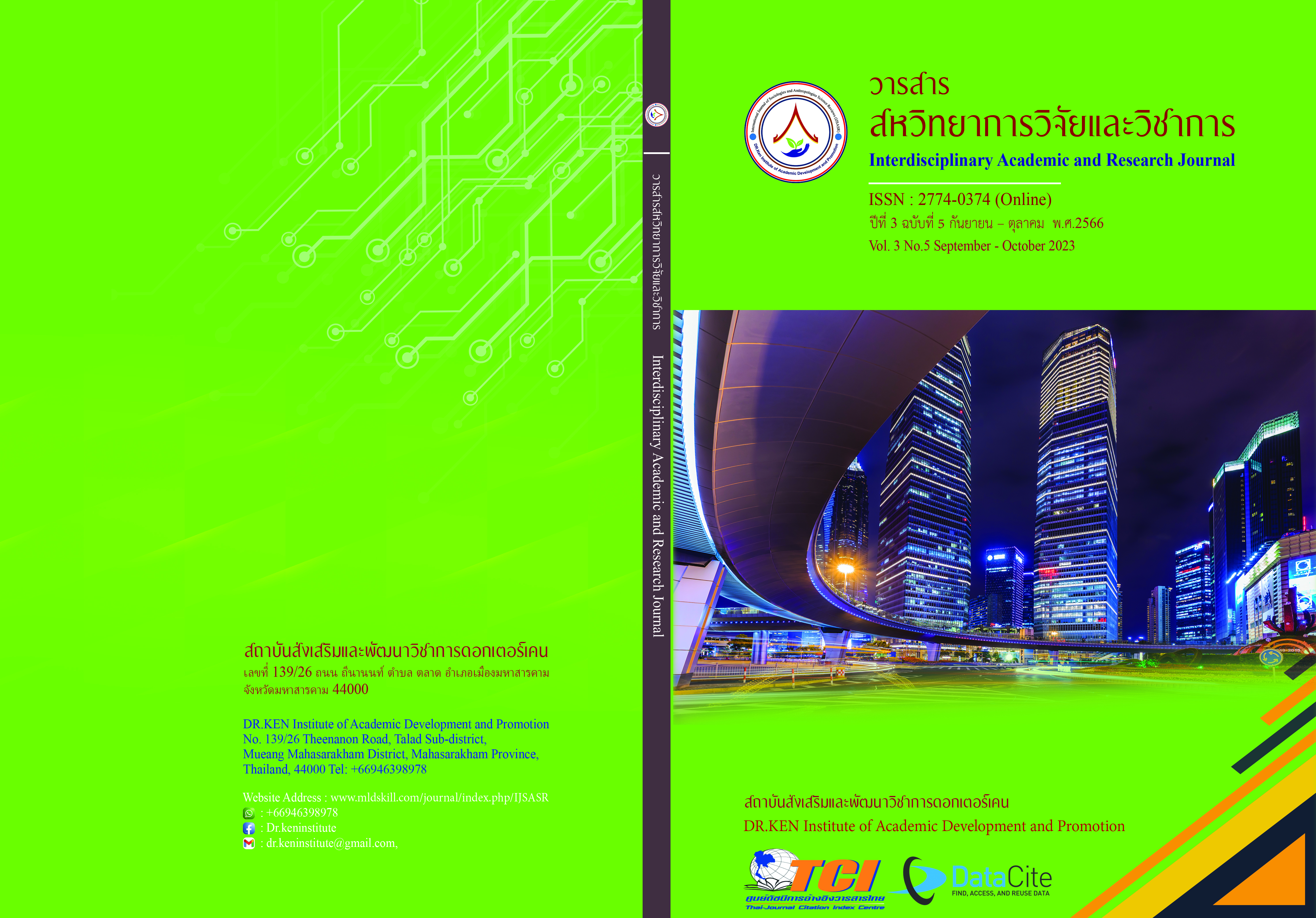Factors Related to Social Skills of Seventh-Grade Students
DOI:
https://doi.org/10.14456/iarj.2023.260Keywords:
Social Skills; , Multiple Regression Analysis; , Prediction EquationAbstract
Social skills are the ability of a person to communicate with others verbally and non-verbally, recognize one's own and other's emotions, and the ability to control self-expression, interact well with others, understand social contexts, and express one's social role appropriately. Thus, this research aims to examine (1) factors related to the social skills of Matthayom Sueksa One student; and constructs (2) a prediction equation for the social skills of the students under study. The sample population consisted of 2,948 Matthayom Sueksa One student under Samut Prakan Secondary Educational Service Area Office in the second semester of the academic year 2021 using the technique of multi-stage sampling. The research instrument was a questionnaire eliciting the social skills of Matthayom Sueksa One student. The statistics used in data analysis were descriptive statistics and multiple regression analysis. The variables were selected into the equation using the enter method. Findings are as follows: 1) The correlation coefficient (R) of the dependent variable, social skills, and independent variables i.e., family type; family characteristics; school size; instruction and study; relationship with friends; family economic status; and personal attributes was 0.632. 2) Independent variables could be explanatory of variance in dependent variables (Adjusted R2) at 39.80 percent. The Independent variable related to social skills at the highest level was personal attributes (β = 0.461) 3). The relationship could be written in a prediction equation in the raw score as follows: Social skills = 0.706
+ 0.049 parents’ educational level higher than a bachelor’s degree*
+ 0.049 family characteristics*
+ 0.161 instruction and study*
+ 0.066 relationships with friends*
+ 0.530 personal attributes*
+ 0.022 large-sized schools
+ 0.000 parents’ income
- 0.006 nuclear family type
- 0.007 extended family type
- 0.011 extra-large schools
- 0.016 parents’ educational level of a bachelor’s degree
References
น้ำผึ้ง เลาหบุตร. (2560). การพัฒนาความสามารถในการแก้ปัญหาอย่างสร้างสรรค์และทักษะทางสังคม โดยการจัดประสบการณ์เรียนรู้แบบโครงการ สำหรับเด็กปฐมวัย. วิทยานิพนธ์ศึกษาศาสตรมหาบัณฑิต, มหาวิทยาลัยศิลปากร.
พรพรรณ มากบุญ. (2555). ปัจจัยที่มีอิทธิพลต่อทักษะทางสังคมของเด็กและเยาวชนชายในศูนย์ฝึกและอบรมเด็กและเยาวชน เขต 2 จังหวัดราชบุรี. วิทยานิพนธ์ศึกษาศาสตรมหาบัณฑิต, มหาวิทยาลัยศิลปากร.
ภาณุมาศ หอมบุญยงค์. (2562). แนวทางการพัฒนาทักษะทางสังคมของนักเรียนชั้นมัธยมศึกษาปีที่ 6 สังกัดสำนักงานเขตพื้นที่การศึกษามัธยมศึกษาเขต 10 ในจังหวัดสมุทรสงคราม. วิทยานิพนธ์ศึกษาศาสตรมหาบัณฑิต, มหาวิทยาลัยศิลปากร.
ลัดดา แสงเพ็ชร. (2562). ทักษะทางสังคมของนักเรียนระดับประกาศนียบัตรวิชาชีพ วิทยาลัยอาชีวศึกษาเอกชน จังหวัดชลบุรี: การวิจัยแบบผสมผสาน. วิทยานิพนธ์วิทยาศาสตรมหาบัณฑิต, มหาวิทยาลัยบูรพา.
สุวิมล ติรกานันท์. (2555). การวิเคราะห์ตัวแปรพหุในงานวิจัยทางสังคมศาสตร์. พิมพ์ครั้งที่ 2. โรงพิมพ์จุฬาลงกรณ์มหาวิทยาลัย.
Bierman, K.L., Torres, M.M., & Schofield, H.T. (2010). Developmental factors related to the assessment of social skills. In D.W. Nangle, D.J. Hansen, C.A. Erdley & P.J. Norton (Eds.) Practitioner’s Guide to Empirically-Based Measures of Social Skills, pp. 119-134. New York: Springer
Bouqrooz, S. (2017). Social skills: Types, significance, and illustrative theories. Journal of Algerian Childhood and Education, 13, 107-124.
Bremer, C., & Smith, J. (2004). Teaching Social Skills. National Center on Secondary Education and Transition, 3(5), 1-6
Burke, T. J., Woszidlo, A., & Segrin, C. (2012). Social skills, family conflict, and loneliness in families. Communication Reports, 25(2), 75-87.
Campbell, L. (2021). Impact of Covid-19 on Children’s social skills. Retrieved April 15, 2022, from https://www.forbes.com/sites/leahcampbell/2021/10/31/impact-of-covid-19-on-childrens-social-skills/?sh=29fc7f5a2a54
Eleby Jr, C. (2009). The impact of a student's lack of social skills on their academic skills in high school. Michigan: Marygrove College, Detroit.
Joseph, V. (2022). Social Skills: Promoting positive behavior, academic success, and school safety. Retrieved April 1, 2022, https://naspcenter.org/factsheets/social-skills/
Kian, M., Adibnasab, Z., & Izanloo, B. (2020). Social skills in elementary students: The role of attitude to school and school environment. International Journal of School Health, 7(1), 30-39
Mahamid, F. & Bdier, D. (2020). The association between social skills, grief, and resilience among Palestinian university students throughout the coronavirus (COVID-19) Pandemic in Palestine, Journal of Concurrent Disorders, 2(3), 8-23.
Riggio, R.E. (1992). Social interaction skills and nonverbal behavior. In R. S. Feldman (Ed.), Applications of nonverbal behavioral theories and research (pp. 3–30). Lawrence Erlbaum Associates, Inc.
Samanci, O. (2010). Teacher views on social skills development in primary school students. Education is the property of Project Innovation, 31(1), 147-157.
Sørlie, M.A., Hagen, K.A., & Nordahl, K.B. (2021). Development of social skills during middle childhood: Growth trajectories and school-related predictors. International Journal of School & Educational Psychology, 9(S1), S69-S87.
Study Lecture Notes. (2021) Child Social Development, Definition & Factors of Social Development. Retrieved April 14, 2022, from http://studylecturenotes.com/child-social-development-definition-factors-of-social-development/
Tunstall, D. F. (1994). Social competence needs in young children: What the research says. New Orleans: Paper presented at the Association for Childhood Education.
Downloads
Published
How to Cite
Issue
Section
License
Copyright (c) 2023 Rungtiwa Poonsawat, Panida Panidvadtana, Kamaontip Srihaset

This work is licensed under a Creative Commons Attribution-NonCommercial-NoDerivatives 4.0 International License.
Copyright on any article in the Interdisciplinary Academic and Research Journal is retained by the author(s) under the under the Creative Commons Attribution-NonCommercial-NoDerivatives 4.0 International License. Permission to use text, content, images, etc. of publication. Any user to read, download, copy, distribute, print, search, or link to the full texts of articles, crawl them for indexing, pass them as data to software, or use them for any other lawful purpose. But do not use it for commercial use or with the intent to benefit any business.
















.png)


